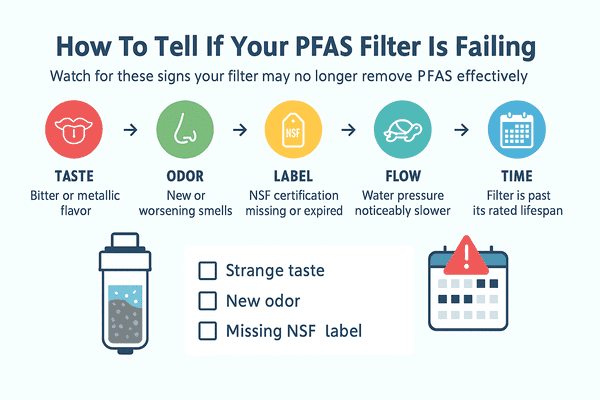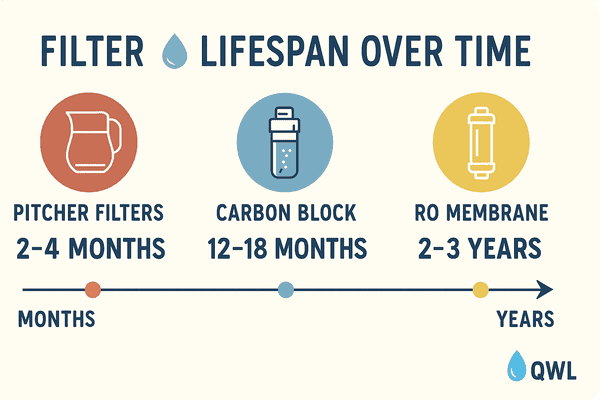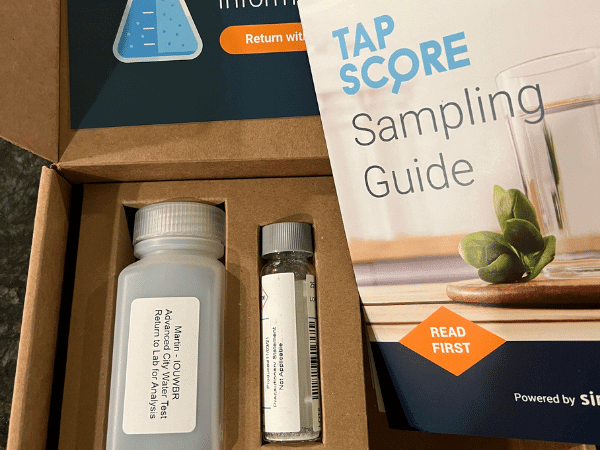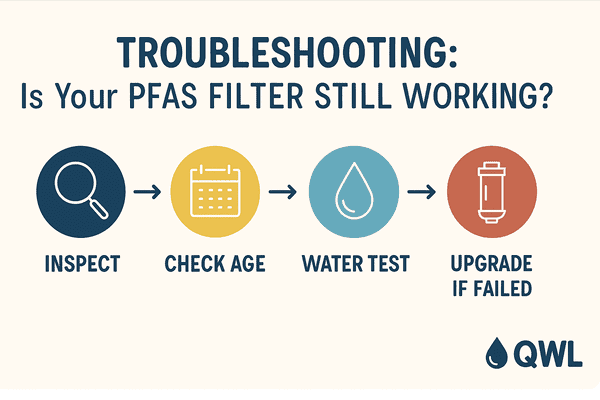Yes, PFAS filters can stop working — often without obvious signs. Over time, the media inside wears out, clogs, or loses effectiveness. If your water starts tasting off, flow slows, or your filter is past its rated lifespan, it’s time to take a closer look. The only way to know for sure? Test your water.
According to the EPA’s newly finalized standards, public utilities must now reduce PFOA and PFOS to 4 parts per trillion — some of the strictest limits ever set. That means if you’re filtering at home, performance matters more than ever.
💡 Key Takeaways
- ⏳ Filter lifespan isn’t forever — even high-end systems degrade
- 🧪 Regular water testing is the only way to confirm PFAS removal
- 🛠️ Clues like taste, odor, or flow issues can signal early failure
- 📜 Not all filters are NSF P473 certified — and some lose it over time

🚰 Why Filtration Isn’t Set-and-Forget
Filters aren’t like coffee makers — you don’t just plug them in and forget about them for two years. Whether you’re using a pitcher, countertop system, or a whole-house setup, every filter has a shelf life.
That’s because media like activated carbon and reverse osmosis membranes physically trap or reject contaminants — and eventually, they max out. Once they’re saturated, these contaminants can start slipping through unnoticed.
And it’s not just PFAS — microplastics can also sneak through when filter media wears out. Learn how to catch these tiny particles before they end up in your glass.
Performance also depends on:
- 💧 Your water source — Heavily contaminated water burns through filters faster
- 🌀 Daily usage — Higher water use = shorter filter life
- 🔁 Maintenance habits — Skipping recommended changes can ruin effectiveness
Think of it like brakes on a car — they don’t fail overnight, but over time? You’ll notice something’s off.

🔍 Signs Your Filter Might Be Failing
Let’s make this unmistakable. These signs usually mean your filter isn’t doing its job anymore — and these contaminants could be sneaking back in:
| 🚩 Sign | 🔍 What It Could Mean |
|---|---|
| 😖 Water tastes or smells off | PFAS are tasteless, but other contaminants breaking through could signal your filter is failing overall |
| 📉 Slow flow rate | Clogged or degraded filter media is restricting water movement |
| 📅 Filter age exceeds lifespan | Pitchers: 2–3 months • Under-sink: 6–12 months • Whole-house: 6–10 years (media) |
| ❌ NSF P473 label missing or expired | The product may no longer meet PFAS removal standards |
| 🧪 Water tests still detect PFAS | Your system isn’t removing them effectively anymore — time to replace or upgrade |
Even if the water still “looks” clean, don’t trust appearances — PFOA and PFOS are invisible and tasteless.
💡 Pro Tip: If your system’s not cutting it anymore (or you’re second-guessing your current setup), here’s a breakdown of filters that actually perform well against “forever chemicals” — no guesswork required: See our shortlist.
🛠️ Why Filters Wear Out (and What to Watch For)

Many people assume that once a filter is installed, the job’s done. But here’s the catch: filtration media degrades. Over time, those tiny pores in activated carbon or the membrane in your RO system get clogged or lose effectiveness — especially if your water has a high contaminant load.
Some systems slow down gradually, while others simply stop catching what they’re supposed to. And unless you’re testing regularly, it’s hard to know when that tipping point hits.
🧃 Pitchers and countertop units tend to wear out the fastest, while whole-house filters last longer — but none are truly “forever” solutions.
⚠️ Quick Clarification: Cartridge vs. Tank-Based Filters
Not all PFAS filters work the same way — and neither do their lifespans:
- 🧃 Pitchers and under-sink systems use replaceable cartridges — these usually need swapping every 2–12 months depending on size and usage.
- 🛢️ Whole-house filters (like SpringWell CF1) use bulk carbon media in a large tank. These don’t have cartridges — instead, the media lasts up to 10 years or 1 million gallons before needing replacement.
Pro Tip: If you’re not sure which kind you have, check for removable cartridges. No cartridge = long-lasting tank system.
| 🧪 Filter Type | ⏳ Avg. Lifespan | 📉 Performance Risks |
|---|---|---|
| 🫗 Pitcher Filter (e.g. Brita) |
2–3 months | Quick media exhaustion, minimal PFAS reduction |
| 🚰 Faucet/Countertop Unit | 3–6 months | Filter fatigue, inconsistent flow |
| 🏠 Carbon Block (Whole House) | 6–18 months | Declining adsorption over time |
| 💧 Reverse Osmosis Membrane | 2–3 years | Clogged membranes, PFAS breakthrough |
💡 Good to know: If your water has visible discoloration, smells off, or hasn’t been tested in a while — it’s worth checking your system’s specs and replacement schedule. Overdue filters aren’t just less effective — they can be downright useless.
🧪 How To Test Your Water

Many people assume their filter must still be working — but the only way to know for sure? Testing.
There are two main ways to check your water:
| 🔍 Method | ⚙️ How It Works | 📦 What You’ll Get | 🧾 Cost |
|---|---|---|---|
| 🧪 DIY Test Kit | You take a sample and send it to a lab | Simple detection of common PFAS compounds | $60–$150 |
| 🧬 Advanced Lab Test | EPA-certified methods (like 537.1) | Full PFAS panel + detailed report | $200–$400+ |
🧠 Good to Know: DIY kits like Tap Score are great for general peace of mind, but if you’re testing after installing a system or need results for legal or health reasons, go with a certified lab.
🔁 When To Replace a Filter (By Type)
There’s no one-size-fits-all answer, but if your filter’s past its prime — these compounds might be slipping through without you knowing it.
⏳ Here’s how long common systems typically last:
| 🧃 Filter Type | ⏱️ Average Lifespan | 📉 Replacement Signs |
|---|---|---|
| Pitcher filters | 2–3 months | Water starts to taste stale or flows slower |
| Under-sink RO filters | 6–12 months (membranes 2–3 yrs) | Low pressure, TDS increases, slow recovery |
| Whole-house tank systems | Up to 10 years or 1 million gallons | Annual testing shows declining reduction |
🛠️ Pro Tip: If you’re guessing based on time alone, you’re already behind. Test your water annually (at least) — especially if you rely on well water or a DIY setup.
🏆 Filters That Work — What to Look For

If your current system’s not cutting it — or you’re starting fresh — go with filters that are lab-tested and certified to reduce PFOA & PFOS. Not just “claims to.”
Here are a few standouts worth considering:
| 💧 System | 📜 Certification | 🔎 Best For |
|---|---|---|
| SpringWell CF (Whole-house) | 99% PFAS Removal Internal Testing |
Large families, city water, whole-home protection |
| WaterDrop G3P800 (Under-sink RO) | NSF 58 & 372 Certified 99% PFAS Removal |
Fast-flow RO for cooking + drinking water |
| Clearly Filtered Pitcher | Independent lab tested 99.5% PFAS Removal |
Affordable PFAS protection in rentals or small homes |
💡 Good to Know: Pitchers and countertop filters are convenient, but for full-house protection (especially for families), a whole-home system like the SpringWell CF1 is a smart long-term move.
🧠 Still Seeing PFAS? Here’s What To Check

If your test results still show this pesky contaminant — even after installing a filter — don’t panic. It’s more common than you’d think, and there’s usually a fix. Let’s walk through the likely reasons and how to troubleshoot them fast:
🧪 First: Double-Check Your System
- 🧾 Is it certified? Look for NSF/ANSI P473 or P231 certification. If your filter only claims “PFAS reduction” without lab testing, it may not do much.
- 🔧 Is it installed correctly? A reversed RO membrane or skipped filter stage can mean water isn’t getting treated.
- 📅 How old is the filter? Even high-end filters lose effectiveness over time. If it’s been more than 6–12 months (or years for tank systems), it might be time to replace the media.
🧼 Then: Check Your Maintenance Routine
- 🧃 For pitchers and under-sink units, swap filters on schedule (or sooner if you notice slow flow)
- 🛢️ For tank systems, test yearly — especially on well water
- 🚱 Flush the system after periods of disuse to avoid bacterial buildup
🔁 Consider an Upgrade If…
- You’re dealing with very high PFAS levels (above 50 ng/L)
- You only have one stage of treatment (e.g. carbon only, no RO)
- You’ve already replaced filters but test results haven’t improved
💡 Good to Know: Combining systems — like carbon + RO — is often the most effective approach, especially for families on well water or in high-risk areas.
📜 What Filter Certifications Actually Mean

If you’ve ever seen a label that says “Reduces PFAS,” you might wonder — what does that actually mean? The truth is, not all filters are held to the same standards.
Here’s how to decode the certifications that matter:
✅ NSF/ANSI P473 — The One to Look For
This is the gold standard for PFAS reduction. It means:
- The filter has been lab-tested to reduce PFOA and PFOS (two of the most common PFAS)
- Testing was done at high contaminant levels
- Flow rate, pressure, and safety were also verified
Filters with this badge are your safest bet.
🔎 NSF 53, 58, or 401 — Related but Not Always PFAS-Specific
These standards may appear on filters too, but they cover:
- NSF 53 → heavy metals, chlorine, VOCs
- NSF 58 → reverse osmosis systems
- NSF 401 → emerging contaminants (pharma, herbicides, etc.)
💡 Some of these systems also reduce PFAS — but unless it explicitly says P473 or PFAS-tested, dig deeper. Read more about what NSF is all about.
🚩 Marketing Claims Without Proof?
Watch out for filters that say:
- “PFAS reduction” with no certification
- “Lab-tested” — but don’t cite a standard or share results
- “Up to 99% effective” — without saying against what
If you don’t see certification details, ask the manufacturer or skip it.
🧠 Pro Tip: You can look up legit certifications using NSF’s official listings tool — just search by brand or model.
🧼 Final Thoughts: Test First, Then Decide
“Forever chemicals” isn’t something you can see, smell, or taste — and that’s what makes it so easy to overlook. Just because your water looks clean doesn’t mean your filter is still doing its job.
If you’ve had the same setup running for a while, or you’re noticing subtle changes (like off taste or slower flow), trust your gut. Revisit your filter’s lifespan, check your water quality, and don’t skip the testing step.
You don’t need a lab coat to stay ahead of synthetic/emerging toxins — just good info, the right tools, and a reminder that even the best filters eventually need a refresh.
💡 Not sure what to do next? A quick water test can reveal a lot — help you decide if it’s time to upgrade your system or replace a worn-out cartridge.
 131 people found this helpful. Was this guide helpful to you?
131 people found this helpful. Was this guide helpful to you? 

